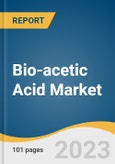The global bio-acetic acid market size is expected to reach USD 317.8 million by 2030, registering a CAGR of 5.3% from 2023 to 2030, as per the new report by the publisher. This is attributable to the increasing demand for acetic anhydride from the global pharmaceutical industry as it is used in the production of various pharmaceuticals such as aspirin, paracetamol, and other analgesics.
It is widely utilized for manufacturing a variety of medicines, including paracetamol. High consumption of paracetamol for fever, headaches, vomiting, body pain, etc. is contributing to the surged usage of products worldwide. Bio-acetic anhydride is also used as a raw material to produce medicines, including theophylline, acetaminophen, cortisone, etc. The market for bio-acetic acid is expected to grow on account of the increasing demand for bio-based medicines at a global level.
Additionally, the higher cost of producing bio-acetic acid is that it often requires more complex and time-consuming production processes compared to traditional acetic acid. For example, bio-acetic acid is often produced through the fermentation of natural sugars or waste materials, which can be a slower and more expensive process compared to producing acetic acid from fossil fuels. Additionally, the cost of raw materials used to produce bio-acetic acid may be higher than traditional fossil-based feedstocks.
High global costs of bio-acetic acid, along with its insufficient feedstock, are expected to restrain the growth of the market for the bio-acetic acid industry across the world in the future. Various factors contributing to the high costs of bio-acetic acid are rising prices of crude oil, surging demand for renewable materials, and increasing investments in green technologies Fluctuations in the prices of raw materials lead to significant spikes in costs of bio-acetic acid owing to the rising global demand for bio-based products.
It is widely utilized for manufacturing a variety of medicines, including paracetamol. High consumption of paracetamol for fever, headaches, vomiting, body pain, etc. is contributing to the surged usage of products worldwide. Bio-acetic anhydride is also used as a raw material to produce medicines, including theophylline, acetaminophen, cortisone, etc. The market for bio-acetic acid is expected to grow on account of the increasing demand for bio-based medicines at a global level.
Additionally, the higher cost of producing bio-acetic acid is that it often requires more complex and time-consuming production processes compared to traditional acetic acid. For example, bio-acetic acid is often produced through the fermentation of natural sugars or waste materials, which can be a slower and more expensive process compared to producing acetic acid from fossil fuels. Additionally, the cost of raw materials used to produce bio-acetic acid may be higher than traditional fossil-based feedstocks.
High global costs of bio-acetic acid, along with its insufficient feedstock, are expected to restrain the growth of the market for the bio-acetic acid industry across the world in the future. Various factors contributing to the high costs of bio-acetic acid are rising prices of crude oil, surging demand for renewable materials, and increasing investments in green technologies Fluctuations in the prices of raw materials lead to significant spikes in costs of bio-acetic acid owing to the rising global demand for bio-based products.
Bio-acetic Acid Market Report Highlights
- The Vinyl Acetate Monomer (VAM) application segment is expected to witness the fastest CAGR of 6.0% from 2023 to 2030, due to the increasing demand for VAM in paints & coatings, plastics, solvents, adhesives, and textiles industries
- North America is expected to register the fastest CAGR of 5.5% from 2023 to 2030, owing to the presence of numerous global multinational companies with high demand from end-use markets such as food & beverages and paints & coatings
- The key market players include Airedale Chemicals; Novozymes A/S; GODAVARI BIOREFINARIES LTD.; and Afyren. These companies are involved in extensive research & development and dominate the global market with their strong presence throughout the value chain
- In February 2022, the Indian Government proposed a reduction in customs duty for essential chemicals such as Methanol, Acetic Acid, and heavy feedstocks for petroleum refining. The purpose of this proposal is to increase the domestic value addition of the aforementioned chemicals within the country
- Various strategic initiatives are being taken by manufacturers to minimize the dependency on a single raw material as well as its supplier. For instance, in 2021, Cargill has been diversifying its supply chain by sourcing bio-acetic acid from multiple suppliers. The company stated that this strategy would help to ensure a reliable supply of market and improve its ability to meet customer demand
Table of Contents
Chapter 1 Methodology and Scope
Chapter 2 Executive Summary
Chapter 3 Bio-Acetic Acid: Market Variables, Trends & Scope
Chapter 4 Bio-Acetic Acid Market: Supplier Portfolio Analysis
Chapter 5 Bio-Acetic Acid Market: Application Estimates & Trend Analysis
Chapter 6 Bio-Acetic Acid Market: Regional Estimates & Trend Analysis
Chapter 7 Competitive Landscape
List of Tables
List of Figures
Companies Mentioned
- Airedale Chemicals
- Bio-Corn Products EPZ Ltd.
- GODAVARI BIOREFINARIES LTD.
- Sucroal SA
- Cargill, Inc.
- Novozymes A/S
- LanzaTech
- Afyren SAS
- BTG Bioliquids
Methodology

LOADING...
Table Information
| Report Attribute | Details |
|---|---|
| No. of Pages | 101 |
| Published | June 2023 |
| Forecast Period | 2022 - 2030 |
| Estimated Market Value ( USD | $ 209.6 Million |
| Forecasted Market Value ( USD | $ 317.8 Million |
| Compound Annual Growth Rate | 5.3% |
| Regions Covered | Global |
| No. of Companies Mentioned | 9 |









